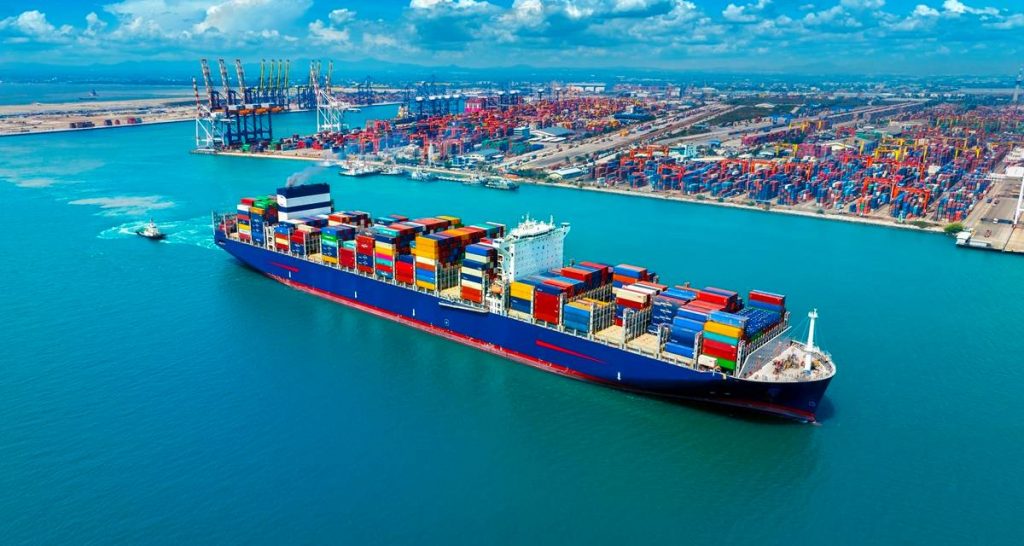
A tank container, also known as a tanktainer, is a specialized shipping container designed for the transport of liquids or gases in bulk. These containers are constructed to meet the stringent requirements for safely transporting hazardous and non-hazardous liquids, including chemicals, fuels, food-grade products, and more.
Tank containers typically feature a cylindrical stainless steel tank within a steel frame that fits the standard dimensions of ISO shipping containers. This allows them to be easily loaded, unloaded, and transported using standard container handling equipment, such as cranes and forklifts, and carried on various modes of transportation, including ships, trains, and trucks.
The tank container design incorporates features such as pressure relief valves, baffles, and protective coatings to ensure the safe and secure transportation of the cargo. They come in various sizes and configurations to accommodate different types of liquids or gases and meet the specific requirements of the cargo being transported.
Tank containers offer several advantages over traditional bulk transport methods, including reduced handling costs, improved safety, and greater flexibility in transportation logistics. They are widely used in industries such as chemical manufacturing, food and beverage production, pharmaceuticals, and oil and gas.
In the intricate dance of global trade, the transportation of liquids, gases, and hazardous materials demands precision, safety, and efficiency. Amid this complex choreography, tank containers have emerged as the unsung heroes of modern logistics, revolutionizing the way we move essential cargo across vast distances. From ISO tank specifications to specialized designs, let’s unravel the mysteries of tank containers and explore how they power the engine of contemporary commerce.
The Rise of Tank Containers: A Game-Changer in Intermodal Transport
In the world of bulk transportation, versatility is key. Tank containers offer a flexible solution for shipping everything from food-grade products to chemicals, providing a secure vessel for diverse cargo types. According to the International Tank Container Organization (ITCO), the global tank container fleet surpassed a staggering 736,000 units in 2022, marking a 7.3% increase in just one year. This meteoric rise underscores the indispensable role these containers play in the modern supply chain.
Decoding ISO Tank Containers: Specifications and Safety Features
At the heart of the tank container revolution lies the ISO standard, ensuring uniformity and reliability in every shipment. These cylindrical pressure vessels, encased within a robust steel framework measuring 20′ x 8′ x 8.6′, adhere to stringent safety protocols for transporting hazardous and non-hazardous liquids in bulk. But what sets ISO tank containers apart from their standard counterparts?
Diving Deeper: Understanding Tank Container Types and Variations
Not all tank containers are created equal. From Twinpots to T50s and T75s, each variant serves a distinct purpose in the logistics ecosystem. Let’s take a closer look at some of the specialized designs that cater to specific cargo requirements:
-
Twinpots: These 20ft T11 containers boast dual chambers, allowing simultaneous transport of two different products. Equipped with identical valves to their single-chamber counterparts, Twinpots offer enhanced versatility without compromising on safety.
-
Ground Operated Vapor Return (GOVR): Designed for operator convenience and safety, these containers feature ground-level operation, eliminating the need for precarious climbs during handling. Ideal for plants lacking adequate fall protection measures, GOVR technology ensures seamless operations and mitigates workplace hazards.
-
Baffled Tanks: By incorporating internal baffles, standard T11 containers minimize cargo movement during transit, enhancing stability and safety. Whether filled to 20% or 95% capacity, baffled tanks mitigate the notorious “wave effect,” ensuring a smooth journey for sensitive cargo.
-
T14 and T20: Differentiated by shell thickness and maximum working pressure, these specialized containers cater to unique cargo requirements, offering enhanced leak-proofing and structural integrity.
-
T50 and T75: Engineered for high-pressure gases and cryogenic liquids respectively, these UN portable tank containers adhere to stringent regulatory standards, ensuring safe and efficient transport of volatile cargoes.
Special containers
Special containers refer to shipping containers that are designed to accommodate cargo that requires specific handling or storage conditions beyond what standard containers can provide. These containers are engineered to meet the unique needs of certain types of cargo, ensuring their safe and secure transportation.
Here are some examples of special containers:
-
Refrigerated Containers (Reefers): These containers are equipped with built-in refrigeration units to maintain specific temperature conditions, typically used for transporting perishable goods such as fruits, vegetables, dairy products, and pharmaceuticals.
-
Open-top Containers: Open-top containers have a removable top or convertible roof that allows for easy loading and unloading of oversized cargo or goods that need to be loaded from the top, such as machinery, timber, or scrap metal.
-
Flat Rack Containers: Flat rack containers feature collapsible or removable sides, allowing for easy loading and unloading of cargo that is oversized, bulky, or awkwardly shaped, such as machinery, vehicles, or large industrial equipment.
-
Tank Containers (Tanktainers): Tank containers are specialized containers with cylindrical stainless steel tanks designed for transporting liquids or gases in bulk, such as chemicals, fuels, food-grade products, or liquefied gases.
-
Bulk Containers: These containers are designed for transporting dry bulk cargo, such as grains, coal, ores, or fertilizers, and often feature specialized loading and unloading systems, such as pneumatic or gravity discharge.
-
Insulated Containers: Insulated containers are equipped with insulation materials to regulate temperature and protect cargo from temperature variations, making them suitable for goods that require temperature control but not refrigeration, such as chocolate or pharmaceuticals.
-
Ventilated Containers: Ventilated containers are designed with openings or vents to allow for airflow, reducing moisture buildup and preventing condensation, making them suitable for transporting goods that require ventilation, such as coffee beans or spices.
-
High Cube Containers: High cube containers have extra height compared to standard containers, providing additional storage capacity and accommodating taller cargo, such as furniture, machinery, or oversized equipment.
These special containers offer flexibility and customization options to meet the diverse requirements of different types of cargo, ensuring their safe and efficient transportation across various modes of transportation, including ships, trains, and trucks.
Innovations in Heating Technology: Keeping Cargo Safe and Secure
As the logistics landscape evolves, so too do the technologies that power it. Electrical heated tanks, equipped with sophisticated heating systems, ensure that temperature-sensitive cargo reaches its destination unscathed. Whether utilizing glycol heating or electrical elements, these advanced solutions offer precise temperature control, safeguarding delicate shipments throughout the journey.
FAQs: Navigating the World of Tank Containers
Q: What distinguishes a tank container from an ISO tank?
A: While standard containers are typically made of aluminum or steel and come in fixed sizes, ISO tank containers feature high-grade stainless steel construction and adhere to rigorous ISO certification standards, ensuring suitability for transporting liquids, gases, and hazardous materials.
Q: What are some common variations of tank containers?
A: Tank containers come in a myriad of configurations, including Twinpots for dual-chamber transport, GOVR-equipped containers for ground-level operation, and specialized variants like T14 and T20 designed for specific cargo types.
Q: How do heating systems enhance the safety of tank containers?
A: Heating systems, such as glycol heating and electrical elements, ensure that temperature-sensitive cargo remains within optimal conditions throughout transit, minimizing the risk of spoilage or degradation.
To summarize…
Tank containers represent the pinnacle of efficiency and safety in modern logistics, enabling the seamless transport of essential goods across continents. As global trade continues to evolve, these indispensable vessels will remain steadfast pillars of the supply chain, driving progress and prosperity in the interconnected world of commerce.

Written by Michael Zippo
Michael Zippo, passionate Webmaster and Publisher, stands out for his versatility in online dissemination. Through his blog, he explores topics ranging from celebrity net worth to business dynamics, the economy, and developments in IT and programming. His professional presence on LinkedIn - https://www.linkedin.com/in/michael-zippo-9136441b1/ - is a reflection of his dedication to the industry, while managing platforms such as EmergeSocial.NET and theworldtimes.org highlights his expertise in creating informative and timely content. Involved in significant projects such as python.engineering, Michael offers a unique experience in the digital world, inviting the public to explore the many facets online with him.
